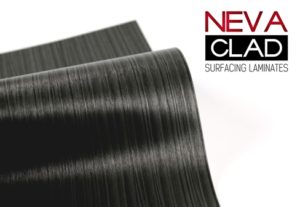
NevaClad® Surfacing Laminates are a series of decorative, thermo-flexible laminates designed for use as an after-market, new-finish alternative for updating the look and appearance of existing fixtures and surfaces. NevaClad combines aspects of a high-pressure laminate (e.g., finish options and impact resistance) with those of a thermofoil (e.g., flexibility and conformability) to form an innovative surfacing material that functions, quite literally, as an on-demand instant finish. NevaClad comes in a wide range (1,500+ patterns) of wood-grain, stone, metallic, leather, sand, and solid-color designs. As a foil-type laminate, NevaClad is manufactured in a rolled form and equipped with an integrated adhesive system which minimizes the need for additional adhesives (for installation), allowing for easy applications to take place in the field. Typical factory-roll sizes are 48″ wide and contain 50 linear meters (~162 feet) of continuous material.
How is NevaClad utilized during the reimaging & revitalization process?
NevaClad’s high degree of flexibility and integrated adhesive system make it a very straightforward and less labor-intensive surfacing material to install in the field. As a result, installations are quicker to perform and highly cost-effective. A typical NevaClad project starts with the surface preparation of the substrate that is to be reimaged. Damaged laminate (or veneer) is either sanded smooth or patched using a two-part polyester filler (i.e., Bondo). The area is then cleaned thoroughly with a degreaser, such as denatured alcohol. The NevaClad laminate is unrolled and cut to the dimensions of the substrate or fixture to be recladded (e.g., office door or countertop). There is a protective release liner (covering the NevaClad adhesive layer) that is removed during the installation process. Utilizing a manufacturer-approved smoothing applicator, the adhesive system is fully activated by applying pressure and heat. Once it is applied, NevaClad forms an instant bond that reaches permanent bond strength in 8-12 hours. During the application process, heat can also be used to make the laminate pliable so that it is able to be conformed to convex or compound-radius objects. For applications that involve countertops and work surfaces, the last part of the revitalization process entails the installation of a new, protective edge molding that is color-matched to the NevaClad finish. The molding protects both the existing substrate and the new NevaClad finish from repeated exposure to abuse, such as chairs or objects (i.e., coin rolls) repeatedly knocking into them.
